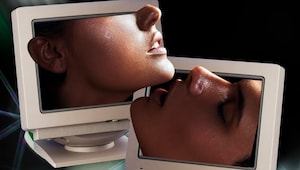This is what’s really making your hair greasy (and how to break the cycle)
Experts spill the (hair) tea on what’s actually making your roots greasy—and how to stop the oil slick before it takes over your scalp.

Ignorance may be bliss, but not when it’s sitting on your scalp in the form of excess oil. If your roots start to feel greasy barely a day after washing, it’s easy to blame your genetics, the weather, or your daily commute through city smog. And while those factors do influence how your scalp behaves, they’re only part of the equation.
What many people overlook is that oil production is actually your scalp’s built-in defence mechanism; it is its own way of keeping the skin protected and balanced. But when that balance is disrupted, things go downhill fast.
Oily hair isn’t just the result of overactive sebaceous glands; it’s often shaped by the way you treat your scalp, the products you rely on, and the habits you repeat without a second thought. From high humidity to harsh cleansers, your scalp is constantly adapting, sometimes overcompensating, and quietly signalling that something is off. The result? Hair that looks flat by noon clings to your head and resists any attempt at volume or freshness.
But treating oily hair isn’t about stripping it clean or switching shampoos endlessly, it’s about understanding the triggers, correcting the cycle, and building a consistent, year-round routine that respects your scalp’s ecosystem.
Here's how to do it methodically, mindfully, and with expert-backed strategies that work long after the rinse.
The shampoo trap: why overwashing is making it worse
Washing your hair more often than usual might seem logical, but it can backfire by overstimulating sebaceous glands. Instead, focus on gentle yet effective cleansing strategies.
Dr Shareefa Chause, dermatologist at Dr Shareefa Skin Care Clinic, Mumbai, recommends, “Start by opting for a sulfate-free, clarifying shampoo twice a week to remove buildup without over-drying your scalp.” Focus the product on your scalp, not the lengths of your hair, and always rinse with lukewarm water, never hot.
Echoing a more holistic perspective, Dr Blossom Kochhar, pioneer in aromatherapy and chairperson of the Blossom Kochhar Group of Companies, advises steering clear of synthetic ingredients altogether: “Use a mild, natural shampoo free from parabens, sulfates, petrochemicals, and artificial additives.”
Your scalp deserves exfoliation, too
Dead skin, leftover product, and city grime don’t just weigh your hair down—they clog follicles and ramp up oil production. Translation: greasy roots, fast.
“Incorporate a weekly scalp exfoliation using salicylic acid or clay,” recommends Shawn Peppin, creative director and trainer at Jean Claude Biguine & Bounce Salons. “It helps reset oil production and keeps the scalp balanced.”
Prefer a natural route? Dr Kochhar suggests her go-to scalp-cleansing pack: mix two parts shikakai powder, one part green gram flour, and half a part fenugreek powder with water to form a paste. Apply it to the scalp, leave on for 30 minutes, and rinse off—no lather, just a deep herbal detox.
Dry shampoo isn’t lazy—it’s a strategy
When you're skipping wash day, dry shampoo isn't just a cover-up—it's your scalp’s secret weapon. “On days you don't wash your hair, use a dry shampoo on your scalp,” says Peppin. “It helps absorb excess oil without further irritating the scalp.”
Styling smart also helps. “Preferably, tie your hair loosely or go for styles like braids to reduce friction and oil transfer,” says Dr Chause. “And avoid tying your hair too tightly—it can stress your scalp and trigger more oil production.”
Habits that secretly trigger greasiness
Sometimes, it’s not your shampoo—it’s your habits. Touching your hair constantly? You're transferring oil from your fingers and triggering your scalp to produce even more oil. Over-brushing has a similar effect, pushing oils from roots to ends faster than you can say “volume.”
Your lifestyle plays a bigger role than you think. “Eating right, taking omega-3 supplements, and staying physically active can visibly improve scalp health,” says Dr Falguni Shah, founder of Radiance Skin Clinic. She also recommends a weekly apple cider vinegar rinse—diluted in water—to help rebalance your scalp’s pH. “Just remember to patch test first, especially if you have sensitive skin.”
Oily hair might be stubborn, but with the right habits, thoughtful product choices, and a little consistency, your scalp can find its balance.
Lead image: Pexels
Also read: The new ColorBar is here, heralding an era of hyper-inclusive beauty
Aslo read: These high-performance skincare serums are like Botox in a bottle
more from Beauty

The goth-girl fashion bible for a darkly romantic winter wardrobe

Top 10 romantic movies and shows that will give you the butterflies this cuffing season

What your skincare routine secretly says about your attachment style

24 steamy sex games for couples

The lazy girl’s guide to looking like you slept eight hours (even if you didn't)

For every girlfriend out there, here's your sign to start your boyfriend’s wardrobe makeover

Is it sexual tension? Here are 10 signs you can’t miss

Why millennials who still live with their parents are frustrated all the time

Why society loves to turn a woman’s choices into embarrassment for the men around her

Your pollution-proof skincare routine to survive India’s smog season
